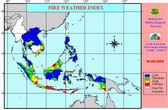GFMC: Meterological Conditions and Fire in South East Asia
SouthEast Asia
RegularFire and Weather Update
17 March 2006
Latest satellite image from fires in Southeast Asia
Across several countries in southeast Asia, the Moderate Resolution Imaging Spectroradiometer (MODIS) on NASAs Aqua satellite detected hundreds of fires (marked in red) when it captured this image on 17 March 2006.

AQUA
17 March 2006
5:10 hrs UTC
Fires stretch across India, Myanmar, Thailand, China, Laos, and Vietnam. At this time of year, the majority of the fires are probably agricultural fires that people set to clear and renew land for farming and grazing of livestock. Although such fires are not necessarily immediately hazardous, they can have a big influence on public health, natural resources, and climate.
Smog over the Pacific Ocean
Pollution plumes from Asia can be observed in satellite imagery as they spread far out over the Pacific Ocean, and in some instances the plumes reach the western coast of the United States. Over China, industrial emissions are mainly responsible for the high levels of carbon monoxide observed in the image. In Southeast Asia (lower left corner), February and March are months for widespread agricultural burning, and the carbon monoxide over that region may be from the high number of fires.

Terra- MOPITT
1 March 2006
(source: Earth Observatory)
This false-color image shows the concentrations of carbon monoxide in the atmosphere off the coast of Asia and out over the Pacific Ocean. This image represents a composite of data collected during February 2006 by the Measurements of Pollution in the Troposphere (MOPITT) instrument aboard NASAs Terra satellite. The colors represent the amount of carbon monoxide in a column of air, given in molecules per square centimeter. The gray areas show where no data were collected due to persistent cloud cover.
I. Monitoring of Smoke-Haze and Active Fires (land-use fires and wildfires)
Regional Smoke-Haze Monitoring
The provides a daily updated map showing active fires (land-use fires, wildfires), smoke haze and surface wind directions within the South East Asian region.
Latest map of surface winds and smoke haze/hot spots observed over cloud-free areas.
(Source: http://app.nea.gov.sg/cms/htdocs/article.asp?pid=1195)
-
Latest regional active fire (hotspot) maps:
http://app.nea.gov.sg/cms/htdocs/article.asp?pid=1674 -
Forecast of winds and surface pressure for the South East Asian Region:
http://app.nea.gov.sg/cms/htdocs/article.asp?pid=1122 - Other Regional NOAA and GOES Satellite Images:
http://app.nea.gov.sg/cms/htdocs/category_sub.asp?cid=59 - Update of Regional Weather and Smoke Haze for the last Month:
http://app.nea.gov.sg/cms/htdocs/article.asp?pid=1196
Fire Activity Monitoring in Borneo (Kalimantan, Sabah, Sarawak)
The Integrated Forest Fire Management Project (IFFM) in Samarinda provides regulary updated maps generated by NOAA-AVHRR showing active land-use fires and wildfires in Brunei and the Indonesian and Malaysian provinces on Borneo Island.
Latest fire overview map for Borneo: 15 December 2004
(Source: IFFM Fire Maps)
Fire Activity Monitoring in South Sumatra
The South Sumatra Forest Fire Management Project provides regular fire activity maps based on the products of the MODIS Rapid Response System: http://www.ssffmp.or.id/ssffmp/fwi-2.asp?id=2
II. Fire Weather and Fire Danger Monitoring and Early Warning
Regional Fire Weather
The Regional South East Asia Fire Danger Rating System (SEA FDRS) is a joint effort between the Canadian Forest Service (CFS) and the Malaysian Meteorological Service (MMS), supported by the Canadian International Development Agency (CIDA). Daily updated SEA Fire Danger Rating can be downloaded on the following website of MMS, and background information on the project can be found at the SEA FDRS Project website.
Latest example of a SEA FDRS product:
The Fire Weather Index (FWI) values shown on the map are numerical ratings of fire intensity.
Information from the Initial Spread Index (ISI) and Build Up Index (BUI) is combined to provide a numerical rating of fire intensity.
This index is used to indicate the difficulty of fire control based on the head fire intensity and fire fighting capability.
Information on the Indonesian Fire Danger Rating System (Indonesian FDRS) is provided by the Indonesian Bureau of Meteorology and Geophysics (BMG) in Jakarta. The site provides information for fire managers working to prevent and control vegetation fires and smoke in Indonesia. This link points to the English version; a Bahasa Indonesian version can be found there as well: http://www.bmg.go.id:8080/fdrs/index_e.html.
The GFMC displays selected and daily updated global and Asia-Pacific Experimental Climate Prediction Center (ECPC) Fire Weather Forecasts. These examples allow a quicklook and provide daily and weekly total forecasts and forecasted monthly totals. For background information refer to the ECPC products description page.
tomorrow week monthly
Fire Weather Index (FWI) forecast for this week (left) and the predicted FWI total for next month (right)
for the Western Pacific (1-3) and the Pacific Ocean (4-6) regions.
The weekly total forecast and the monthly forecasted total refer to 00:00 hrs UTC, which is local noon at dateline (180° longitude).
Forecast time is 12:00 hrs noon UTC (Greenwich) corresponding to local evening time in mainland and insular SE Asia.
(Source: ECPC Fire Weather Index Forecast)
III. Further information:
-
The ASEAN Haze Action Online provides the following information:
- Monitoring: Hyperlinks to institutions involved in regional monitoring and prediction of fire and smoke haze
- Haze News: ASEAN Transboundary Haze Update (updated daily)
- Intranet: Information and possible participation in the ASEAN Haze Action Online Intranet Information Services (for associated registered participants)
- Mobilization Plan: Model Fire Suppression Mobilization Plan
- Inventory: Inventory and analysis of forest and land fire suppression capabilities
- Haze Forum: Communication platform on fire and smoke-haze issues in the ASEAN region
- Calendar: Fire and haze-related events can be identified by a search modus
- Media Highlights on Fire, Policies, and Politics












